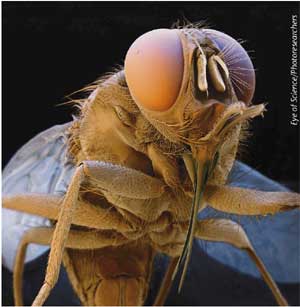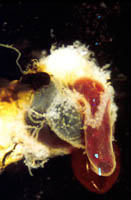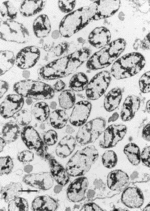Wigglesworthia: Difference between revisions
No edit summary |
|||
| (7 intermediate revisions by 2 users not shown) | |||
| Line 1: | Line 1: | ||
{{Biorealm}} | {{Curated}} | ||
{{Biorealm Genus}} | |||
[[Image:ng1102-335-I1.jpg|thumb|300px|right|''Glossina sp.,'' which houses ''Wigglesworthia glossinidia''.[http://www.nature.com/cgi-taf/DynaPage.taf?file=/ng/journal/v32/n3/full/ng1102-335.html Eye of Science/Photoresearchers.]]] | [[Image:ng1102-335-I1.jpg|thumb|300px|right|''Glossina sp.,'' which houses ''Wigglesworthia glossinidia''.[http://www.nature.com/cgi-taf/DynaPage.taf?file=/ng/journal/v32/n3/full/ng1102-335.html Eye of Science/Photoresearchers.]]] | ||
| Line 17: | Line 14: | ||
''Wigglesworthia glossinidia, W. pallidipes'' | ''Wigglesworthia glossinidia, W. pallidipes'' | ||
{| | |||
| height="10" bgcolor="#FFDF95" | | |||
'''NCBI: [http://www.ncbi.nlm.nih.gov/Taxonomy/Browser/wwwtax.cgi?mode=Info&id=51228&lvl=3&lin=f&keep=1&srchmode=1&unlock Taxonomy] [http://www.ncbi.nlm.nih.gov/genomes/framik.cgi?db=Genome&gi=15960 Genome]''' | |||
|} | |||
==Description and Significance== | ==Description and Significance== | ||
''Wigglesworthia'', discovered by British entomologist Sir Vincent Brian Wigglesworth, are Gram-negative bacteria. Although much is known about its symbiotic relationship with the tsetse fly (''Glossina'' spp.), few other characteristics of ''Wigglesworthia'' are understood because attempts to cultivate it in a laboratory setting have not yet been successful. | ''Wigglesworthia'', discovered by British entomologist Sir Vincent Brian Wigglesworth, are Gram-negative bacteria. Although much is known about its symbiotic relationship with the tsetse fly (''Glossina'' spp.), few other characteristics of ''Wigglesworthia'' are understood because attempts to cultivate it in a laboratory setting have not yet been successful. It is vital for the success of tsetse fly populations, providing immune functions and vitamins necessary for reproduction. | ||
==Genome Structure== | ==Genome Structure== | ||
The ''[http://www.ncbi.nlm.nih.gov/genomes/framik.cgi?db=Genome&gi=15960 Wigglesworthia glossinidia genome]'' was first sequenced in 2002, by Leyla Akman and Serap Aksoy. However, more research on the genome sequence is being completed on a regular basis. Because the organism cannot be cultivated in a laboratory, Akman and Aksoy took the bacterial DNA directly from tsetse fly guts. The ''Wigglesworthia ''genome is one of the smallest genomes sequenced, since the genome shrunk over the years. Since it co-evolved with the tsetse fly, it was able to eliminate genes already contained by its host. Although a symbiotic organism, the ''Wigglesworthia glossinidia'' genome contains many genes of free-living organisms, such as genes for motility. | The ''[http://www.ncbi.nlm.nih.gov/genomes/framik.cgi?db=Genome&gi=15960 Wigglesworthia glossinidia genome]'' was first sequenced in 2002, by Leyla Akman and Serap Aksoy. However, more research on the genome sequence is being completed on a regular basis. Because the organism cannot be cultivated in a laboratory, Akman and Aksoy took the bacterial DNA directly from tsetse fly guts. The ''Wigglesworthia ''genome is one of the smallest genomes sequenced, since the genome shrunk over the years. Since it co-evolved with the tsetse fly, it was able to eliminate genes already contained by its host. It has retained at least 62 genes involved in the biosynthesis of vitamin cofactors and carriers, indicating the nutritious value of ''Wigglesworthia'' to its host. Although a symbiotic organism, the ''Wigglesworthia glossinidia'' genome contains many genes of free-living organisms, such as genes for motility. | ||
==Cell Structure and Metabolism== | ==Cell Structure and Metabolism== | ||
| Line 38: | Line 40: | ||
[[Image:wiggles3.gif|thumb|150px|left|''Wigglesworthia glossinidia'' cells in the gut of ''G. morsitans''. [http://ijs.sgmjournals.org/cgi/reprint/45/4/848 Aksoy, "''Wigglesworthia'' gen. nov. and ''Wigglesworthia glossinidia'' sp. nov., Taxa Consisting of of the Mycetocyte-Associated, Primary Endosymbionts of Tsetse Flies."]]] | [[Image:wiggles3.gif|thumb|150px|left|''Wigglesworthia glossinidia'' cells in the gut of ''G. morsitans''. [http://ijs.sgmjournals.org/cgi/reprint/45/4/848 Aksoy, "''Wigglesworthia'' gen. nov. and ''Wigglesworthia glossinidia'' sp. nov., Taxa Consisting of of the Mycetocyte-Associated, Primary Endosymbionts of Tsetse Flies."]]] | ||
''Wigglesworthia'' is best known for the symbiotic relationship between ''Wigglesworthia glossinidia'' and the tsetse fly. In fact, ''W. glossinidia'' is unable to survive outside of its host. Research suggests that the bacteria infected its host 50 to 80 million years ago. Bacteria are vertically transmitted, passed from mother to | ''Wigglesworthia'' is best known for the symbiotic relationship between ''Wigglesworthia glossinidia'' and the tsetse fly. In fact, ''W. glossinidia'' is unable to survive outside of its host. Research suggests that the bacteria infected its host 50 to 80 million years ago. Bacteria are vertically transmitted, passed from mother to intrauterine larva through milk gland secretions. ''Wigglesworthia glossinidia'' is housed in specialized cells called mycetocytes (bacteriocytes). The mycetocytes form a specialized organelle called the mycetome in the anterior midgut, whose main function is to house endosymbiotic bacteria. The intracellular bacteria live freely in the cell cytoplasm and are not surrounded by host membranes. Some ''Wigglesworthia glossinidia'' live extracellularly in the milk gland lumen to be passed on to intrauterine larva. The tsetse fly transmits African trypanosomes, parasites that cause African sleeping sickness. ''Wigglesworthia glossinidia'' is acquired through reproduction; mother flies pass it on to their young. The tsetse fly requires this bacterium to provide it with vitamins not naturally found in its diet. These vitamins are required for the fly's fertitliy. Without the bacteria, the female tsetse fly cannot reproduce. Antibiotics have not been shown to affect spermatogenesis in male tsetse flies. | ||
Within the tsetse fly, the trypanosomes aggregate around the mycetocytes, suggesting that they obtain nutrients from ''W. glossinidia'' as well. Currently, researchers are studying ways to remove ''Wigglesworthia glossinidia'' from the gut of the fly, thus controlling African sleeping sickness. Research performed by Dale and Welburn (2001) indicates that broad-spectrum antibiotics such as ampicillin an tetracycline destroy ''Wigglesworthia glossinidia'', preventing growth and reproduction in its host. | Within the tsetse fly, the trypanosomes aggregate around the mycetocytes, suggesting that they obtain nutrients from ''W. glossinidia'' as well. Currently, researchers are studying ways to remove ''Wigglesworthia glossinidia'' from the gut of the fly, thus controlling African sleeping sickness. Research performed by Dale and Welburn (2001) indicates that broad-spectrum antibiotics such as ampicillin an tetracycline destroy ''Wigglesworthia glossinidia'', preventing growth and reproduction in its host. | ||
| Line 53: | Line 55: | ||
[http://www.genomenewsnetwork.org/articles/09_02/wiggles.shtml Dalke, Kate. "''Wigglesworthia'' wiggles into the world of sequenced genomes." ''Genome News Network''. 13 September 2002. Accessed 12 July 2005.] | [http://www.genomenewsnetwork.org/articles/09_02/wiggles.shtml Dalke, Kate. "''Wigglesworthia'' wiggles into the world of sequenced genomes." ''Genome News Network''. 13 September 2002. Accessed 12 July 2005.] | ||
[https://www.researchgate.net/profile/Jingwen_Wang3/publication/23158266_The_Obligate_Mutualist_Wigglesworthia_glossinidia_Influences_Reproduction_Digestion_and_Immunity_Processes_of_Its_Host_the_Tsetse_Fly/links/555bfe3a08ae91e75e76c04c.pdf Pais, Roshan R., Claudia Lohs, Yineng Wu, Jingwen Wang, and Serap Askoy. “The obligate mutualist Wigglesworthia glossinidia influences reproduction, digestion, and immunity processes of its host, the tsetse fly.” ''Applied and Environmental Microbiology''. October 2008. Accessed 11 May 2016.] | |||
[http://www.ncbi.nlm.nih.gov/pubmed/22334516 Rio, Rita V.M., Rebecca E. Symula, Jingwen Wang, Claudia Lohs, Yi-neng Wu, Anna K. Snyder, Robert D. Bjornsen, Kenshiro Oshima, Bryan S. Biehl, Nicole T. Perna, Masahira Hattori, and Serap Askoy. "Insight into the Insight into the transmission biology and species-specific functional capabilities of tsetse (Diptera: Glossinidae) obligate symbiont Wigglesworthia." ''MBIO''. February 2012. Accessed 11 May 2016.] | |||
[http://www.med.yale.edu/external/pubs/ym_sp03/findings.html Ross-Flanigan, Nancy. "In microbe’s genome, a potential target." ''Yale Medicine''. Spring 2003. Accessed 14 July 2005.] | [http://www.med.yale.edu/external/pubs/ym_sp03/findings.html Ross-Flanigan, Nancy. "In microbe’s genome, a potential target." ''Yale Medicine''. Spring 2003. Accessed 14 July 2005.] | ||
[http://www.genomenewsnetwork.org/articles/06_01/Wigglesworthia.shtml Trivedi, Bijal P. "Using ''E. coli'' gene arrays to explore genome of the tsetse fly microbe ''Wigglesworthia glossinidia''." ''Genome News Network''. 25 June 2001. Accessed 12 July 2005.] | [http://www.genomenewsnetwork.org/articles/06_01/Wigglesworthia.shtml Trivedi, Bijal P. "Using ''E. coli'' gene arrays to explore genome of the tsetse fly microbe ''Wigglesworthia glossinidia''." ''Genome News Network''. 25 June 2001. Accessed 12 July 2005.] | ||
Latest revision as of 23:43, 13 May 2016
A Microbial Biorealm page on the genus Wigglesworthia

Classification
Higher order taxa:
Bacteria; Proteobacteria; Gammaproteobacteria; Enterobacteriales; Enterobacteriaceae
Species:
Wigglesworthia glossinidia, W. pallidipes
Description and Significance
Wigglesworthia, discovered by British entomologist Sir Vincent Brian Wigglesworth, are Gram-negative bacteria. Although much is known about its symbiotic relationship with the tsetse fly (Glossina spp.), few other characteristics of Wigglesworthia are understood because attempts to cultivate it in a laboratory setting have not yet been successful. It is vital for the success of tsetse fly populations, providing immune functions and vitamins necessary for reproduction.
Genome Structure
The Wigglesworthia glossinidia genome was first sequenced in 2002, by Leyla Akman and Serap Aksoy. However, more research on the genome sequence is being completed on a regular basis. Because the organism cannot be cultivated in a laboratory, Akman and Aksoy took the bacterial DNA directly from tsetse fly guts. The Wigglesworthia genome is one of the smallest genomes sequenced, since the genome shrunk over the years. Since it co-evolved with the tsetse fly, it was able to eliminate genes already contained by its host. It has retained at least 62 genes involved in the biosynthesis of vitamin cofactors and carriers, indicating the nutritious value of Wigglesworthia to its host. Although a symbiotic organism, the Wigglesworthia glossinidia genome contains many genes of free-living organisms, such as genes for motility.
Cell Structure and Metabolism

Wiggleworthia are rod-shaped. Although they are nonmotile, these organisms do contain genes that synthesize for flagella.
Wigglesworthia is an obligate organism. It recieves nutrients from the tsetse fly. However, little is known about this organism's metabolic processes because it is so difficult to study.
The Wigglesworthia life cycle is typical of other bacteria; it includes reproduction by division.
Ecology

Wigglesworthia is best known for the symbiotic relationship between Wigglesworthia glossinidia and the tsetse fly. In fact, W. glossinidia is unable to survive outside of its host. Research suggests that the bacteria infected its host 50 to 80 million years ago. Bacteria are vertically transmitted, passed from mother to intrauterine larva through milk gland secretions. Wigglesworthia glossinidia is housed in specialized cells called mycetocytes (bacteriocytes). The mycetocytes form a specialized organelle called the mycetome in the anterior midgut, whose main function is to house endosymbiotic bacteria. The intracellular bacteria live freely in the cell cytoplasm and are not surrounded by host membranes. Some Wigglesworthia glossinidia live extracellularly in the milk gland lumen to be passed on to intrauterine larva. The tsetse fly transmits African trypanosomes, parasites that cause African sleeping sickness. Wigglesworthia glossinidia is acquired through reproduction; mother flies pass it on to their young. The tsetse fly requires this bacterium to provide it with vitamins not naturally found in its diet. These vitamins are required for the fly's fertitliy. Without the bacteria, the female tsetse fly cannot reproduce. Antibiotics have not been shown to affect spermatogenesis in male tsetse flies.
Within the tsetse fly, the trypanosomes aggregate around the mycetocytes, suggesting that they obtain nutrients from W. glossinidia as well. Currently, researchers are studying ways to remove Wigglesworthia glossinidia from the gut of the fly, thus controlling African sleeping sickness. Research performed by Dale and Welburn (2001) indicates that broad-spectrum antibiotics such as ampicillin an tetracycline destroy Wigglesworthia glossinidia, preventing growth and reproduction in its host.
